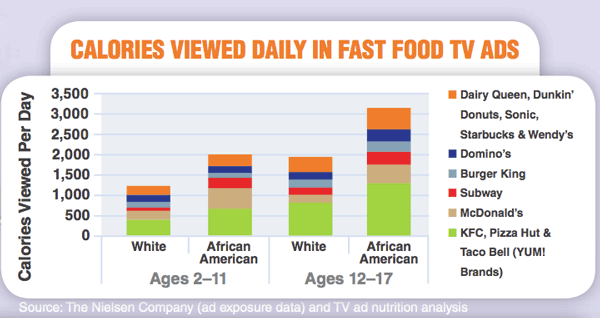By FALPC Intern, Kristina Kalolo
The Yale Rudd Center for Food Policy and Obesity recently released their Fast Food F.A.C.T.S. (Food Advertising to Children and Teens Score) report investigating the nutritional value of children’s meals and marketing strategies fast food restaurants target at youth. The group argues that, “Objective and transparent data are necessary to evaluate restaurants’ progress in reducing marketing that promotes consumption of unhealthy fast food by children and teens.” With 33% of children and 41% of teens consuming fast food every day, as well as widespread obesity in the United States, this group takes seriously the behavior of this multi-billion dollar industry.
Nutrition Results
 There are improvements in kids’ meal options since 2010. Despite this, nearly every item of fast food menus surpass recommended levels of calories, fat, sodium, and sugar for children and teens. Out of the 5,427 possible kids’ meal combinations, only 33 meet appropriate nutrition standards for elementary school aged children, that is 1% of all meals.
There are improvements in kids’ meal options since 2010. Despite this, nearly every item of fast food menus surpass recommended levels of calories, fat, sodium, and sugar for children and teens. Out of the 5,427 possible kids’ meal combinations, only 33 meet appropriate nutrition standards for elementary school aged children, that is 1% of all meals.
Marketing to Children
Fast food restaurants (FFR) spent $4.6 billion on advertising in 2012, leading to teens viewing more than 4.8 ads per day. McDonald’s, Subway, Burger King, Domino’s, Yum! Brands (Taco Bell, Pizza Hut), and Wendy’s were responsible for 70% of the television ads. Overall, there were few positive trends in marketing to children and teens. Fast food restaurants continue to target youth of color, particularly black and Hispanic youth, who are already at increased risk for nutrition and weight-related diseases. In 2009, youth of color saw about 60% more fast food ads than white youth.

Recommendations
Healthy kids’ meal options should apply for the majority of meal combinations, not 1%.
1) FFR must improve the overall nutritional quality
- More healthier default side options, such as servings of fruits or vegetables
- Increases in lower-calorie menu items that are reasonable prices
2) FFR need to stop marketing to children and teens with messages that encourages frequent visits
- Only the healthiest children’s meals should be advertised
- Stop marketing that takes advantage of developmental vulnerabilities
- Preschoolers and very young children should be protected from advertising
- Protect tends from advertising that can damage their health
- Child-targeting should meet industry self-regulations of children 12-14
- Establish age limits on marketing through social media and mobile devices

You can find more information, articles, and media clips about the Fast Food FACTS findings here.



